Japan
Wood Products Prices
Dollar Exchange Rates of 10th
Aug
2021
Japan Yen 110.44
Reports From Japan
Corona update
Newly reported COVID-19 cases in Japan exceeded
15,000 for the first time on 5 August and Tokyo reported a
record high 5,042 new cases. Tokyo has been under a state
of emergency since 12 July. In an attempt to curb the
rising infections, Japan expanded emergency restrictions
to eight more prefectures, Fukushima, Ibaraki, Tochigi,
Gunma, Shizuoka, Aichi, Shiga and Kumamoto.
Olympic cost overun
The cost of the just-ended Tokyo Olympics greatly
overrun initial estimates. The Olympics were held without
spectators at almost all venues meaning most of the
US$800 million in estimated ticket revenues did not
materialise. The costs for the games had already ballooned
due the one-year postponement amid the global health
crisis and anti-virus measures and increased construction
expenditures for the venues pushed costs higher.
The total costs for the Tokyo Olympics and Paralympics
were estimated at ¥734 billion but this had grown to ¥1.64
trillion in December 2020.
July consumer confidence improves despite new state
of emergency
The Cabinet Office Consumer Confidence survey for July
reported a 17-month high, returning to pre-pandemic
levels despite a resurgence in infections that forced the
government to declare the fourth state of emergency.
Consumers surveyed were more optimistic about their
livelihood prospects, jobs and suggested government
spending and strong exports boosted confidence.
Japan's seasonally-adjusted consumer confidence index
stood at 37.5 in July, up from 37.4 in June to mark the
second straight month of increase. The Cabinet Office
survey said "While still in a severe state, consumer
confidence continues to recover". While the latest
lockdowns dashed policymakers' hopes for a strong
rebound in the third quarter the government still maintains
GDP will be back to pre-pandemic levels at the end of
2021 but this has not been borne out in a survey of the
private sector.
An NHK survey has found that more than 70 percent of
major companies in Japan expect the economy to recover
to pre-pandemic levels next year and beyond.
Asked when the economy would return to pre-pandemic
levels, 5 companies said in the latter half of this year, 30
said in the first half of 2022 while 24 companies said in
the latter half of 2022. 8 companies said in the first half of
2023 and another 8 said in the latter half of 2023. 3
companies said in the first half of 2024.
Agricultural and forestry exports rise
Japan¡¯s Minister of Agriculture, Forestry and Fisheries,
Kotaro Nogami, reported in an online press conference on
3 August that Japan¡¯s exports of agriculture, forestry and
fishery products increased by 31.6 percent in the first half
of 2021 from the same period last year, the highest ever
for the first half of a year.
Throughout 2020 there was a steady increase in the
exports of Japanese cedar logs to China and this continued
into the first half of 2021. China accounted for the largest
share followed by the Philippines, the United States, South
Korea and Taiwan P.o.C.
Rising raw material costs
Wholesale prices in Japan rose at their fastest annual pace
in July a sign that rising global commodity prices and a
weak yen has pushed up the cost of imported raw
materials. This has become a concern for Japanese
manufacturers as they slowly resume production.
In the second quarter of this year major manufacturers
reported strong export demand especially in the US and
China but optimism is tempered as rising raw material
costs will push up production costs.
The current state of domestic demand is not strong
so
companies hesitate to pass on higher raw material costs to
consumers by raising prices.
Japan¡¯s economy had been showing signs of recovery
with rising exports offsetting weak domestic consumption
but with another state of emergency announced there are
doubts that the pace of recovery can be maintained.
See:
https://www.japantimes.co.jp/news/2021/08/12/business/economy-business/wholesale-inflation-hits-13-year-high-japan-costsimports-rise/
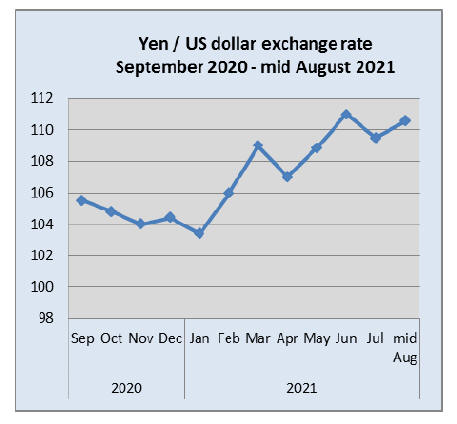
New regulations on home energy saving being
considered
There are on-going discussions on making it mandatory
for new homes to meet energy-saving standards as the
household sector is estimated to account for roughly 15%
of carbon dioxide emissions in Japan and excessive
hosehold power consumption because of poor insulation is
one major factor.
To meet a target of reducing the average energy loss of all
newly built homes to zero by 2030 the government is
promoting ¡°net-zero energy houses¡±.
Some local governments have already adopted energysaving
targets for the household sector. In 2020 the
government of Tottori Prefecture introduced a programme
to certify the heat insulation of homes.
House builders are concerned about the impact of these
measures as they will result in increased house prices.
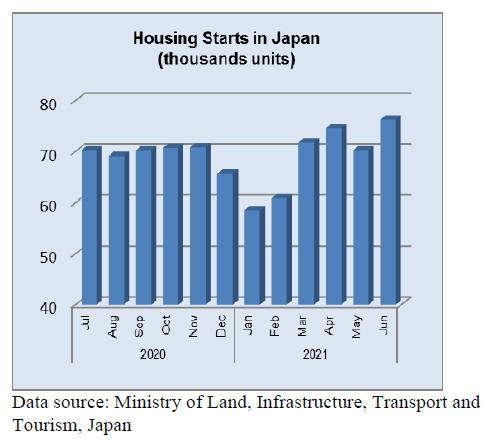
Import update
Wooden door Imports
Japan¡¯s imports of wooden doors (HS441820) in the first
half of 2021 were up 16% on the value of first half 2020
imports but still below levels reported in the first half of
2019. Year on year, the value of June 2021 imports of
wooden doors were 12.5% higher and compared to a
month earlier there was a 12% increase.
As in previous months shippers in China and the
Philippnes accounted for over 80% of June imports of
wooden doors with Malaysia accounting for around 3% of
June imports. The combined value of wooden door
shipments from suppliers in Europe amounted to 6% of the
value of June arrivals.
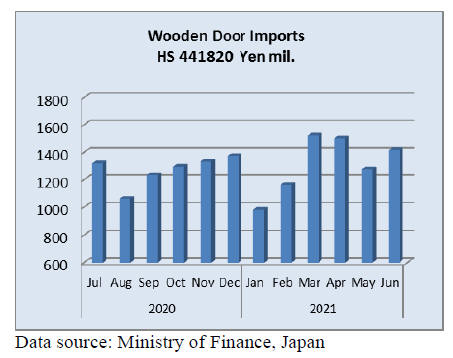
Wooden window imports
Looking at the 12 month trend in the value of wooden
window (HS441810) imports it would appear there has
been a substantial improvement however, in the first half
of 2021 the value of window imports was down on 2020
and down a massive 60% on the value of 2019 imports.
Compared to a month earlier, the value of June window
imports were little changed but year on year there was a
5% rise. There has been a steady rise in the value of
wooden window imports between January and May this
year but this upward trend stalled in June.
Shippers in China accounted for 41% of June arrivals
of
wooden windows followed by the US at 35%. June
shipments from the Philippines dipped to 14% of all June
arrivals marking a decline on the value of May shipments.
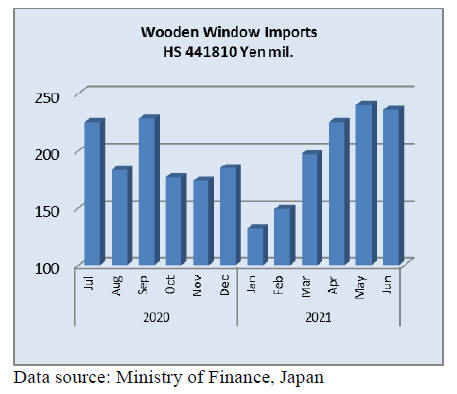
Assembled wooden flooring imports
In the first half of 2021 Japan¡¯s imports of assembled
wooden flooring (HS441871-75) were around the same
level as in 2020 but some 25% below the value of first half
of 2019 imports.
Year on year, the value of Japan¡¯s imports of assembled
wooden flooring (HS441871-79) in June jumped a
remarkable 84% and compared to the value of May
imports there was an over 30% increase.
As in previous months imports of HS441875 acounted for
most assembled flooring imports with most (43%) being
shipped from China. Shippers in Vietnam have been
successful in capturing market share and accounted for
28% of all shipments of HS441875 in June.
In June this year shippers in Malaysia and Indonesia
together accounted for an increased share of imports at
over 12%, a better performance compared to May when
their combined shipments accouted for around 5% of
shipments of HS441875.
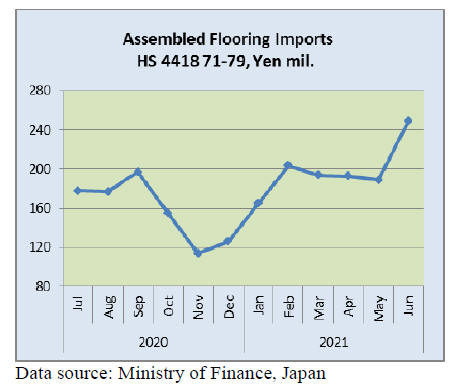
Plywood imports
Plywood imports to japan have been falling steadily for
several years. The volume of first half 2021 plywood
imports was down around 5% from that in 2020 and
around 7% lower than the volume of 2019 imports.

Year on year the volume of Japan¡¯s June imports of
plywood (HS441210-39) was up 8% but compared to May
the volume of imports was little changed.
Of the four main shippers of plywood, Malaysia,
Indonesia China and Vietnam shipments from China were
flat compared to a month earlier, arrivals from Malaysia
were down but shipments from both Indonesia and
Vietnam improved on the May volumes. Shipments of
plywood from Vietnam to Japan are not large but June
shipments were considerably higher than in Juen 2020.
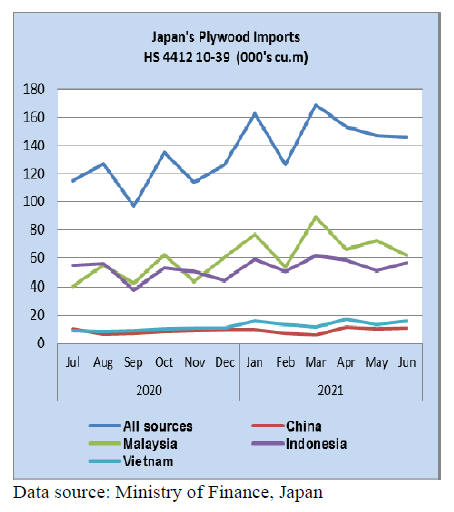 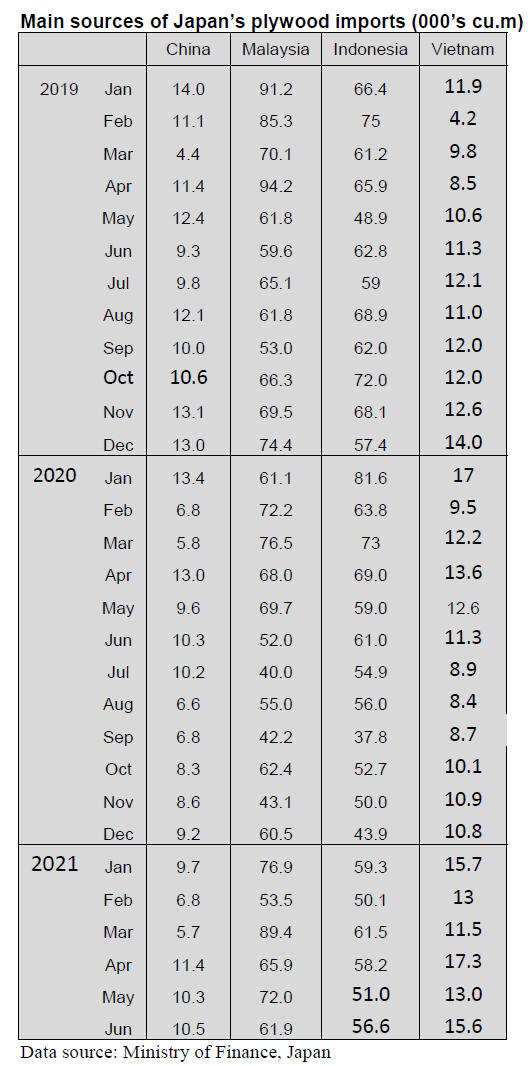
Trade news from the Japan Lumber Reports (JLR)
The Japan Lumber Reports (JLR), a subscription trade
journal published every two weeks in English, is
generously allowing the ITTO Tropical Timber Market
Report to reproduce news on the Japanese market
precisely as it appears in the JLR.
For the JLR report please see:
https://jfpj.jp/japan_lumber_reports/
Front loading of national forest timber sales
With rapid increase of demand of domestic wood, four
regional offices of the national forest management decided
to move up timber sales. With sharp drop of demand,
overall supply reduction was done last year but now it is
reversing to increase the supply.
Log supply from the national forest is about 15% in total
log supply and it is functioning supply and demand. Log
supply shortage started in early this year in some areas and
three regional offices, Kyushu, Kinki/Chugoku and North
East moved up schedule of timber sales then Kanto office
decided to move up timber sales after July.
Log production depends on how soon timber buyers
harvest and produce logs for the market but more timber
sales are up for sale means log production should increase.
In Kyushu, normal bidding rate of timber sales is about
50% but in May, it is surprisingly high of 80% and the bid
prices also climbed. In the North East, snow removal on
logging road was made from beginning of the year to get
logs out, which is unusual event.
North American logs
It is reported that FAS prices of Douglas fir logs for Japan
market on July shipment are US$30 up per M
Scribner.Log market in local markets is rather quiet but
log production is dropping and higher prices are necessary
to secure enough volume.
Ocean freight tis also climbing so that CIF prices are more
than US$60 higher, which is about 1,500 yen per cbm
hike. The largest Douglas fir lumber manufacturer in
Japan announced to increase the sales prices by 15,000
yen per cbm on KD lumber and 10,000-12,000 yen on
green lumber since August 1 after considerable price
increase of competing European redwood laminated
beam for the third quarter.
Severe hot wave hit the West Coast is now gone but dry
condition continues without any rain fall so forest fires
could start up in any day now. Once restriction on logging
starts, log supply will decrease so log prices for August
and September are likely to stay high so domestic Douglas
fir lumber manufacturers would continue raising the sales
prices step by step.
FAS prices of Canadian Douglas fir logs for plywood
mills are about US$140 per cbm FAS, US$5 up from June.
CIF cost would be about US$210, US$10 up.Imported
cost would be about 24,800 yen per cbm CIF, 1,300 yen
up but plywood mills are anxious to procure as domestic
cedar log prices are soaring but like U.S.A., log production
is limited so there is not enough supply to satisfy the
Japanese demand.
Imports from Canada continue increasing month after
month. Total for the first five months is 329,324 cbms,
238.2% more than the same period of last year. The
increase is so conspicuous because last years¡¯ supply
dropped much by harvest stop of the largest supplier.
Douglas fir log supply increase by 29.9% from both
Canada and the U.S.A. This is only increased item when
all the other imported wood products decrease in wood
shock.
Radiata pine logs and lumber
Export industry is not active so that crating lumber
demand for export is dull but supply of crating lumber on
both domestic and import is limited so that the dealers are
trying to secure the volume.
Meantime, because of climbing prices of crating lumber,
some dealers are shifting to use other materials like
cardboard.
Chilean radiate pine lumber¡¯s number second ship arrived
in June. Compared to number one ship, the prices of
number two ship are US$25 per cbm C&F higher so the
dealers are increasing the sales prices.
Dealers¡¯ prices on both thin board and square are 40,000-
43,000 yen per cbm. Number three ship will come in late
July, which prices are up by US$20-25 so the dealers need
to keep pushing the prices.
While the prices are climbing, dealers¡¯ inventory is getting
tight because ships¡¯ interval stretched longer so the dealers
try to limit sales.
Distribution volume of domestic cedar crating lumber is
tight since sawmills concentrate manufacturing
construction lumber. The prices of cedar crating lumber
are also escalating and some prices are higher than Chilean
radiate pine lumber.
New Zealand radiata pine lumber manufacturing mills
announced to increase the sales prices of radiata pine
lumber by 10,000 yen per cbm to 60,000 yen after they
increased the prices in April by 5,000 yen. For crating
panel, Chinese poplar LVL prices are climbing.
Advancing cypress log prices
As reported in last edition, it is big surprise that regular
cypress log prices soared to record high price of 40,000
yen in June and the prices continue advancing. In July the
prices reached 46,000 yen in Shikoku then in Hyogo
prefecture, the auction price hit 48,000 yen. Domestic log
prices have started climbing since last March as a result of
shortage of imported wood products and extreme high
prices. Substituting demand increased in May.
Housing starts are almost the same as last year but
speculative demand pushed lumber prices higher, which
stimulates log demand. Lumber prices climb then log
prices follow to go up.
Plywood mills are also short of logs so that they buy logs
for lumber now. Normally A class logs are straight for
lumber manufacturing and B class logs for plywood. B
class logs are not as good as A class with some curve but
now there is no difference between A and B. Logs with
top diameter of 18-28 cm (nakame) are in high demand
now. Cypress nakame prices for plywood are 30,000 yen
and cedar logs for plywood are 15,000 yen.
There was some excess supply of lumber in March but
since last May, lumber supply became short and in July, it
is scramble to buy lumber. Cypress 4 meter sill square
wholesalers¡¯ prices are 135,000 yen per cbm and 3 meter
cedar post are 105,000 yen which was about 85,000 yen
about a month ago then shot up in short time.
In Kushu, prices of KD and green cypress sill lumber have
been fiercely soaring after cypress log prices reached
40,000 yen.
KD sill lumber prices are 140,000 yen from 80,000 yen a
month ago. Green sill lumber prices also jumped up to
90,000-100,000 yen from 60,000-70,000 yen a month ago.
Marketers comment that the prices would keep going up
toward fall demand.
In Northern Kyushu, KD cedar post prices are 110,000 yen
and cedar purlin prices are 90,000- 95,000 yen, 20,000 yen
up from June. KD cedar post prices are lower than
whitewood laminated post so the dealers are scrambling
but some are not able to procure so that some ordered
houses are short of post and are not able to start up. Some
predict that orders by precutting plants should slow down
so upward move of lumber should ease.
Changing North American lumber market
Average prices of 15 structural lumber dropped down to
US$689 per MBM in the second week of July, which is
continuous decline for seven straight weeks. Compared to
the last peak prices in the third week of May, it is drop of
US$ 825 (54.5%). Canadian SPF 2x4 #2 & better prices
are US$695 per MBM FOB mill, US$15 down from
previous week. Douglas fir KD 2x4 prices are US$850,
US$105 down and hemlock KD 2x4 prices are US$720,
US$165 down.
Compared to the peak prices, Douglas fir green lumber is
down by US$645 (45.8%), Douglas fir KD is down by
US$825 (49.3%) and KD hemlock is down by US$965
(57.3%). However, dropped prices of US$695 on average
15 structural lumber and US$695 on SPF are higher than
record high prices in 2018. Demand for housing has not
dropped that much so once the bottom is confirmed, the
prices are likely to rebound.
It is reported that abnormal high prices are caused by DIY
market where general consumers buy small volume at one
time for renovation of houses but now DIY market is
simmering down after vaccine shots prevailed and from
now on, the prices should settle at practical level.
Recent concern is forest fires on the west coast which
would affect logging activities and may cause log supply
shortage. There will not be any chance to see outrageous
high lumber prices but upward pressure would continue.
|